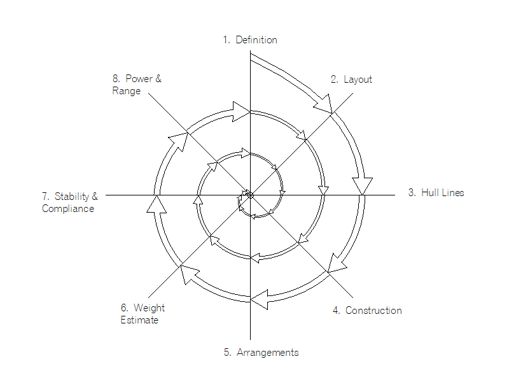How come? How come that passagemaking by motor yacht is expensive, uncomfortable, and less than confidence inspiring? I felt it important to investigate this as a precursor to being able to gain a deeper level of understanding. A deeper level of understanding, that we needed in order to create something different. Luckily, based on our experience in an energy-intensive industry like distillation, where many of our inventions helped redefine an entire economic activity, the answer was easy to find. Here it is: where sail boats use a scarce and low-energy source for thrust, motor yachts have access to an abundant and high-energy source for their propulsion.
The energy-density of wind, the main propulsion-source for sail boats, is low and needs to be looked for. The energy-density of diesel is high and (for power boats with big enough tanks) readily available. Energy-abundance is the enemy of modern motor yacht design, just like energy-shortage is the friend to sail boat design. Let’s dive in deeper and start with how energy-scarcity created great sailing boats!
For their propulsion, sail boats rely on wind. Wind gives off very limited amounts of energy. As a result, sail boats need to be designed with the utmost efficiency in mind. A wide, bulky, heavy sail boat wouldn’t move, where a slender and light boat does. As a result of the energy-scarce propulsion system, sail boats are designed to be very efficient.
Wind comes with an associated risk. When you look to find wind, you are sure to also find waves. Waves rock the boat and make the shortest trip between two points a lot longer. Waves, potentially, create discomfort and unsafe situations. The way sail boat design deals with this, is with hull lines that embrace the waves, that are not afraid of water, and that slice through – rather than bob over – the waves.
Now onwards with long range motor yachts! The abundance of energy in power boats has led to designs that are bulkier rather than slender. Waves are countered by Portugese bridges, higher bulwarks, raised pilot houses, and – generally – more power (to push all the associated additional weight through the water). Does the resulting ship not meet its speed or range objectives? Add a bigger engine, add bigger tanks, build a bigger ship. The additional buoyancy makes those ships bob over the waves, creating an inefficient, uncomfortable sea state. More technology is the answer. Bigger radars, bigger stabilizers, etc. help counter adverse circumstances, but come at a price, both financially, and in weight and energy management.
Do you start to see why crossing an ocean on a motor yacht is not something to look forward to? What I want you to take away from this blog post is that this disheartening outcome is the result of design. It is the result of design choices. Different choices may lead to more efficient and more comfortable passagemaking. What’s needed is an outside in approach to ship design. Instead of starting with the lay-out and then building a ship around it, we need to go back to square one. A well-designed explorer yacht is designed outside in. It starts with sea state, sea comfort, and hull efficiency. An efficient hull slices through the waves, spends less energy, and creates a more comfortable yet wetter ride. If wet is a problem, please go explore the Sahara and forget about the Big Blue Sea.
The motor yacht design cycle is flawed: it places layout before hull lines …







